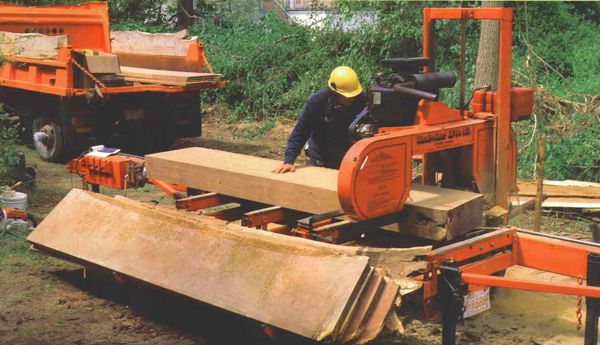Lumber from Your Own Backyard
Hire a sawyer and his machine to reap furniture-grade lumber at great savings
Synopsis: Hiring a sawyer to bring in a portable bandsaw mill is a great way to get lumber at a good price, writes Gus Carlson, who harvests, saws, and dries wood for a living. Carlson explains how to find a sawyer and advises avoiding very large and very small logs, because that drives up your cost. Prices might be set by the board foot or by the hour. A bandsaw mill doesn’t waste much wood, but don’t count on all the lumber being perfect. Carlson includes a “logs-to-lumber” checklist so you can evaluate whether a tree is worth sawing up, and another checklist asks the questions you need to answer before calling a sawyer. A side article explains how Anatole Burkin of Fine Woodworking hired tree trimmers and a sawyer to turn a tall white oak tree into 400 bd. ft. of lumber for kitchen cabinets.
Early on in my career as a sawyer, I spent an entire day in a customer’s yard cutting lumber for a barn frame. From time to time, I’d notice someone peeking through the curtains. When I’d finished up, the couple who lived there finally came out. They both helped me pack, and as we worked, I learned it had been the woman who had watched all day from the window. She was awestruck by the process of turning trees into lumber. As we were saying our good-byes, she touched my arm and said animatedly, “It’s really like a miracle, isn’t it?” Amen.
Hiring a sawyer to bring in a portable bandsaw mill is a great way to get lumber at a good price. Even if you don’t live on a wooded site, chances are good that sometime during the year a friend, relative or neighbor will need a tree removed. Logs from these trees can be cut into boards right on the spot for much less than you would pay at a lumberyard.
A bandsaw mill doesn’t waste much wood
The advantages of having a bandsaw mill do the sawing are many. I have owned and operated such a mill for several years. The mill is mounted on wheels and can be towed on the highway with a pickup truck to the site where the trees were cut. This eliminates the difficulty and cost of transporting logs and, even more important, puts the milling operation directly under your observation. You’re guaranteed to get all the lumber cut, and you can advise the sawyer how you’d like the log sawn. My mill, which is fairly typical, can saw logs up to 36 in. dia. and 21 ft. long, so all but the largest trees can be accommodated.
Another advantage of having your lumber bandsawn—especially for craftsmen interested in furniture-grade lumber—is that so much less wood ends up as sawdust than with any other method of milling (see the photo at right). Compared to a circular-saw mill, a bandsaw yields 25% to 30% more board feet from the same log. Chainsaw mills waste even more wood than a circular sawmill. I know—I owned one for years.
Bandsaw-mill manufacturers advertise this fact, but I still had a hard time believing it at first. Repeated measurements have convinced me, however, that a bandsaw consistently yields at least 25% more than the International Log Scale (an industry benchmark) suggests when sawing lumber 2 in. thick or less.
From Fine Woodworking #128
For the full article, download the PDF below:
Fine Woodworking Recommended Products

AnchorSeal Log and Lumber End-Grain Sealer

Incra Miter 1000HD

Starrett 12-in. combination square




















Log in or create an account to post a comment.
Sign up Log in